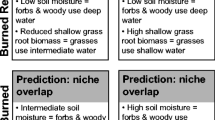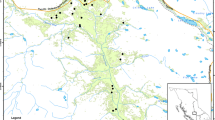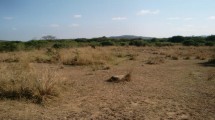Abstract
Grazing lawn and flammable-tussock grass communities are contrasting resource pools for mammalian grazers in terms of forage quantity and quality. Drought events fundamentally alter forage availability within these communities and therefore should alter herbivore use with repercussions for the recovery and functioning of ecosystems after drought. During and after an intense El Niño drought (2014–2017) in Kruger National Park, South Africa, we addressed two questions: (1) how does herbivore use of different grass types change during a drought and (2) how do these changes affect grass productivity post-drought? We monitored grazer use of three different grass communities (lawn, tussock and burned-tussock) at a landscape scale and measured primary productivity monthly during and post-drought. For the first drought year, grazer numbers were highest on grazing lawn communities. This pattern continued into the second dry growing season, until herbivores finally left the study area. Both lawns and tussock grasslands recovered rapidly after the first good rainfall (productivity > 150 g m−2 per month). However, grazers did not return to feed on the same patches they had frequented pre-drought resulting in grazing lawn grasses self-shading and senescing. Longer droughts have the potential to decouple grazers and grazing lawns with negative impacts on lawn productivity and persistence that could drive the loss of lawns in savanna landscapes and impact mesoherbivore populations. It is clear from our results that grazer effects need to be incorporated into drought frameworks to understand the consequences of droughts for grassland function.





Similar content being viewed by others
Data Availability
Data have been submitted to South African National Parks (SANParks) online data repository http://dataknp.sanparks.org/sanparks/metacat/judithk.111311.2/sanparks.
References
Anderson TM, Hopcraft JGC, Eby SL, Ritchie M, Grace JB, Olff H. 2010. Landscape-scale analyses suggest both nutrient and antipredator advantages to Serengeti herbivore hotspots. Ecology 91:1519–29. http://www.ncbi.nlm.nih.gov/pubmed/20503883. Accessed 27 Jan 2015.
Anderson TM, Kumordzi BB, Fokkema W, Valls Fox H, Olff H. 2013. Distinct physiological responses underlie defoliation tolerance in African lawn and bunch grasses. Int J Plant Sci 174:769–778.
Archibald S, Bond WJ. 2004. Grazer movements: Spatial and temporal responses to burning in a tall-grass African savanna. Int J Wildl Fire 13:377–85.
Archibald S, Bond WJ, Stock WD, Fairbanks DHK. 2005. Shaping the landscape: fire-grazer interactions in an African savanna. Ecol Appl 15:96–109.
Arnold SG, Anderson TM, Holdo RM. 2014. Edaphic, nutritive, and species assemblage differences between hotspots and matrix vegetation: two African case studies. Biotropica 46:387–94.
Augustine DJ. 2004. Influence of cattle management on habitat selection by impala on central Kenyan rangeland. J Wildl Manag 68:916–23.
Augustine DJ, McNaughton SJ. 2006. Interactive effects of ungulate herbivores, soil fertility, and variable rainfall on ecosystem processes in a semi-arid savanna. Ecosystems 9:1242–56.
Augustine DJ, McNaughton SJ, Frank DA. 2003. Feedbacks between soil nutrients and large herbivores in a managed savanna ecosystem. Ecol Appl 13:1325–37.
Bates D, Mächler M, Bolker BM, Walker SC. 2015. Fitting linear mixed-effects models using lme4. J Stat Softw 325:883–5. http://www.sciencemag.org/cgi/doi/10.1126/science.1176170. Accessed 17 Oct 2017.
Biondini ME, Patton BD, Nyren PE. 1998. Grazing intensity and ecosystem processes in northern-mixed grass prairie, USA. Ecol Appl 8:469–79.
Bond WJ, Keeley JE. 2005. Fire as a global ‘herbivore’: the ecology and evolution of flammable ecosystems. Trends Ecol Evol 20:387–94. http://www.ncbi.nlm.nih.gov/pubmed/16701401. Last accessed 15/06/2011.
Bonnet O, Fritz H, Gignoux J, Meuret M. 2010. Challenges of foraging on a high-quality but unpredictable food source: the dynamics of grass production and consumption in savanna grazing lawns. J Ecol 98:908–16. http://doi.wiley.com/10.1111/j.1365-2745.2010.01663.x. Last accessed 24/02/2012.
Briggs JM, Knapp AK. 1995. Interannual variability in primary production in tallgrass prairie: climate, soil moisture, topographic, and fire as determinants of aboveground biomass. Am J Bot 82:1064–9.
Buis GM, Blair JM, Burkepile DE, Burns CE, Chamberlain AJ, Chapman PL, Collins SL, Fynn RWS, Govender N, Kirkman KP, Smith MD, Knapp AK. 2009. Controls of aboveground net primary production in mesic savanna grasslands: an inter-hemispheric comparison. Ecosystems 12:982–95.
Burkepile DE, Burns CE, Tambling CJ, Amendola E, Buis GM, Govender N, Nelson V, Thompson DI, Zinn AD, Smith MD. 2013. Habitat selection by large herbivores in a southern African savanna: the relative roles of bottom-up and top-down forces. Ecosphere 4:1–19.
Codron D, Codron J, Lee-Thorp JA, Sponheimer M, de Ruiter D, Sealy J, Grant R, Fourie N. 2007. Diets of savanna ungulates from stable carbon isotope composition of faeces. J Zool 273:21–9. http://doi.wiley.com/10.1111/j.1469-7998.2007.00292.x. Last accessed 28/06/2011.
Crawley MJ, Ed. 2012. The R book. West Sussex: Wiley.
Cromsigt JPGM, te Beest M. 2014. Restoration of a megaherbivore: landscape-level impacts of white rhinoceros in Kruger National Park, South Africa. J Ecol 102:566–75.
Cromsigt JPGM, Olff H. 2008. Dynamics of grazing lawn formation: an experimental test of the role of scale-dependent processes. Oikos 117:1444–52.
Cromsigt JPGM, Rensburg SJ, Etienne RS, Olff H. 2009. Monitoring large herbivore diversity at different scales: comparing direct and indirect methods. Biodivers Conserv 18:1219–31. http://www.springerlink.com/index/10.1007/s10531-008-9506-1. Last accessed 28/08/2011.
Fay PA, Carlisle JD, Knapp AK, Blair JM, Collins SL. 2003. Productivity responses to altered rainfall patterns in a C4-dominated grassland. Oecologia 137:245–51.
Frank DA, Kuns MM, Guido DR. 2002. Consumer control of grassland plant production. Ecology 83:602–6.
Fuhlendorf SD, Engle DM. 2001. Restoring heterogeneity on rangelands: ecosystem management based on evolutionary grazing patterns. Bioscience 51:625.
Fuhlendorf SD, Engle DM, Kerby J, Hamilton R. 2009. Pyric herbivory: rewilding landscapes through the recoupling of fire and grazing. Conserv Biol 23:588–98.
Gertenbach WPD. 1983. Landscapes of the Kruger National Park. Koedoe 26:9–121.
Gizaw MS, Gan TY. 2017. Impact of climate change and El Niño episodes on droughts in sub-Saharan Africa. Clim Dyn 49:665–82.
Hema EM, Di Vittorio M, Barnes RF, Guenda W, Luiselli L. 2017. Detection of interannual population trends in seven herbivores from West African savannah: a comparison between dung counts and direct counts of individuals. Afr J Ecol 55:609–17.
Hempson GP, Archibald S, Bond WJ, Ellis RP, Grant CC, Kruger FJ, Kruger LM, Moxley C, Owen-Smith N, Peel MJS, Smit IPJ, Vickers KJ. 2015. Ecology of grazing lawns in Africa. Biol Rev 90:979–94. http://rstb.royalsocietypublishing.org/lookup/doi/10.1098/rstb.2015.0309. Accessed 20 Sept 2016.
Kleynhans EJ, Jolles AE, Bos MRE, Olff H. 2010. Resource partitioning along multiple niche dimensions in differently sized African grazers. Oikos 120:591–600.
Knapp AK, Hoover DL, Blair JM, Buis GM, Burkepile DE, Chamberlain A, Collins SL, Fynn RWS, Kirkman KP, Smith MD, Blake D, Govender N, O’Neal P, Schreck T, Zinn A. 2012. A test of two mechanisms proposed to optimize grassland aboveground primary productivity in response to grazing. J Plant Ecol 5:357–65.
Koerner SE, Collins SL. 2014. Interactive effects of grazing, drought, and fire on grassland plant communities in North America and South Africa. Ecology 95:98–109.
Macandza VA, Owen-Smith N, Cross PC. 2004. Forage selection by African buffalo in the late dry season in two landscapes. S Afr J Wildl Res 34:113–21.
Mc Naughton SJ. 1979. Grazing as an optimization process: grass-ungulate relationships in the Serengeti. Am Nat 113:691–703.
Mc Naughton SJ. 1984. Grazing lawns: animals in herds, plant form, and coevolution. Am Nat 124:863–86. http://www.jstor.org/stable/2461305. Accessed 14 Apr 2011.
Mc Naughton SJ. 1985. Ecology of a grazing ecosystem: the Serengeti. Ecol Monogr 55:259–94. http://www.jstor.org/stable/1942578. Accessed 19 Jan 2011.
Mc Naughton SJ. 1990. Mineral nutrition and seasonal movements of African migratory ungulates. Nature 345:613–15.
Mc Naughton SJ, Banyikwa FF, Mc Naughton MM. 1997. Promotion of the cycling of diet-enhancing nutrients by African grazers. Science (80-) 278:1798–800.
Mc Naughton SJ, Milchunas DG, Frank DA. 1996. How can net primary productivity be measured in grazing ecosystems? Ecology 77:974–7.
Mucina L, Rutherford MC, Eds. 2006. The vegetation of South Africa, Lesotho and Swaziland. Pretoria: South African National Biodiversity Institute.
O’Connor TG. 1991. Patch colonization in a savanna grassland. J Veg Sci 2:245–54.
O’Connor TG. 1994. Composition and population responses of an African savanna grassland to rainfall and grazing. J Appl Ecol 31:155–71.
O’Connor TG. 1995. Transformation of a savanna grassland by drought and grazing. Afr J Forage Sci 12:53–60.
Owen-Smith N, Ogutu JO. 2013. Controls over reproductive phenology among ungulates: allometry and tropical-temperate contrasts. Ecography (Cop) 36:256–63.
Owen-Smith N, Traill LW. 2017. Space use patterns of a large mammalian herbivore distinguished by activity state: fear versus food? J Zool 303:281–90.
van der Plas F, Zeinstra P, Veldhuis M, Fokkema R, Howison R, Olff H. 2013. Responses of savanna lawn and bunch grasses to water limitation. Plant Ecol 214:1157–68.
R Development Core Team. 2016. R: A language and environment for statistical computing, reference index. Version 3.3.1. Vienna, Austria: R Foundation for Statistical Computing. Retrieved from http://ww-w.R-project.org.
Ratnam JV, Behera SK, Masumoto Y, Yamagata T. 2014. Remote effects of El Nino and Modoki events on the austral summer precipitation of southern Africa. Am Meteorol Soc 27:3802–16.
Ribeiro PJ, Diggle PJ. 2016. Package ‘geoR’.
Sensenig RL, Demment MW, Laca EA. 2010. Allometric scaling predicts preferences for burned patches in a guild of East African grazers. Ecology 91:2898–907.
Simpson KJ, Ripley BS, Christin PA, Belcher CM, Lehmann CER, Thomas GH, Osborne CP. 2016. Determinants of flammability in savanna grass species. J Ecol 104:138–48.
Singh RS. 1993. Effect of winter fire on primary productivity and nutrient concentration of a dry tropical savanna. Vegetatio 106:63–71.
Smith MD. 2011. An ecological perspective on extreme climatic events: a synthetic definition and framework to guide future research. J Ecol 99:656–63.
Tainton NM. 1999. Veld management in South Africa. Pietermaritzberg: Natal University Press.
Tomor BM, Owen-Smith N. 2002. Comparative use of grass regrowth following burns by four ungulate species in the Nylsvley Nature Reserve, South Africa. Afr J Ecol 40:201–4.
Venter FJ, Scholes RJ, Eckhardt HC. 2003. The abiotic template and its associated vegetation pattern. In: Du Toit JT, Rogers KH, Biggs HC, Eds. The Kruger experience: ecology and management of savanna heterogeneity. Washington: Island Press. p 83–129.
Waldram MS, Bond WJ, Stock WD. 2008. Ecological engineering by a mega-grazer: white rhino impacts on a South African savanna. Ecosystems 11:101–12.
Walker BH, Emslie RH, Owen-Smith N, Scholes RJ. 1987. To cull or not to cull: lessons from a Southern African drought. J Appl Ecol 24:381–401.
Whyte IJ, Joubert SCJ. 1988. Blue wildebeest population trends in the Kruger National Park and the effects of fencing. S Afr J Wildl Res 18:78–87.
Yahdjian L, Sala OE. 2006. Vegetation structure constrains primary production response to water availability in the Patagonian steppe. Ecology 87:952–62.
Yoganand K, Owen-Smith N. 2014. Restricted habitat use by an African savanna herbivore through the seasonal cycle: key resources concept expanded. Ecography (Cop) 37:969–82.
Zuur AF, Ieno EN, Walker NJ, Saveliev AA, Smith GM. 2009. Mixed effects models and extensions in ecology with R. New York: Springer.
Acknowledgements
We thank Khensani Mkhonto for collecting data in the field. We are grateful to SANParks and Working on Fire for their continued support, particularly Navashni Govender and Tercia Strydom. This work was funded by the USAID/NAS program “Partnerships for Enhanced Engagement in Research” (Sub-Grant 2000004946, Cycle 3) and the Andrew Mellon Foundation. JED was funded by the National Research Foundation Freestanding, Innovation and Scarce Skills Development Fund (Grant No. 94250).
Author information
Authors and Affiliations
Corresponding author
Electronic supplementary material
Below is the link to the electronic supplementary material.
Rights and permissions
About this article
Cite this article
Donaldson, J.E., Parr, C.L., Mangena, E.H. et al. Droughts Decouple African Savanna Grazers from Their Preferred Forage with Consequences for Grassland Productivity. Ecosystems 23, 689–701 (2020). https://doi.org/10.1007/s10021-019-00438-x
Received:
Accepted:
Published:
Issue Date:
DOI: https://doi.org/10.1007/s10021-019-00438-x




